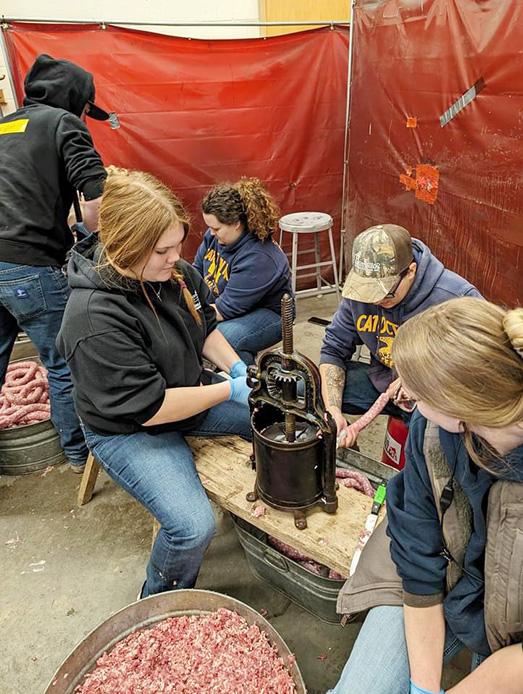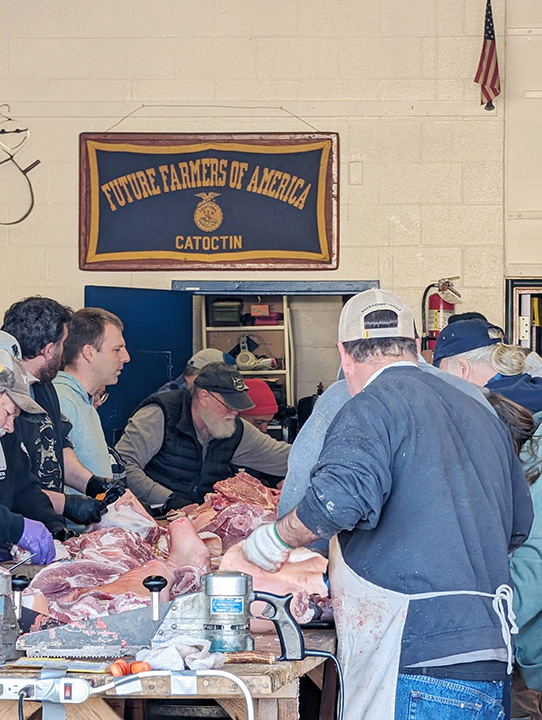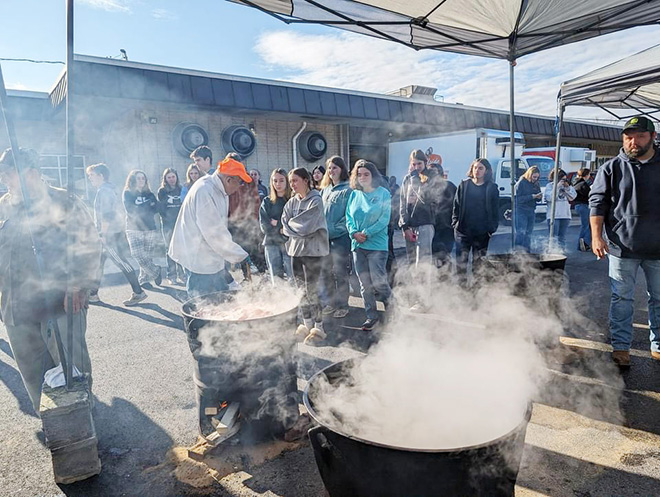Danielle Jackson
Do you know where your food comes from? How is it processed? Or even packaged? A lot of people think that their food comes from a store. But how does it get there? What steps are taken to get it to your table? This is something that is slowly slipping away from younger generations today.
Today’s youth are not as educated about the agricultural industry and where their food comes from. But the Catoctin High School FFA Chapter in Thurmont has a passion for agriculture and teaching! They keep our youth informed, educated, and active in the agriculture industry.
Every year in February, the Catoctin High School FFA Chapter, the Catoctin FFA Alumni and Supporters Chapter, and surrounding community members all come together to participate in their annual hog butchering.
This year, the annual butchering was held on February 9 and took place in the agriculture area and agriculture classrooms at Catoctin High School. The day started around 7:00 a.m. and didn’t end until all the orders were processed and picked up. The Catoctin High School teachers, staff, and administration have always been so supportive of this tradition. Many teachers even bring their classes to the butchering. The butchering isn’t just an agricultural lesson or experience, it can be tied into other aspects of learning, too, such as math, science, photography, social studies, health, and history. Some of the teachers who bring their classes to visit create lesson plans and assignments based on the butchering. Math teachers will incorporate the scales and weighing of the processed meat into their assignments. Some science teachers will include the biology and chemistry of butchering in their lessons. Health teachers can incorporate how pork is an excellent source of protein, vitamins, and minerals.
Any student who is part of the Catoctin High School FFA Chapter or in any ag class at the high school can participate in the butchering if their grades are eligible. Students help cut up meat, package meat, stuff sausage into casings and bags, and fill customer orders in the evening. By doing this, ag students actively experience the hard work that goes into a butchering, and they learn how food is processed and then put on their own tables. The experience also gives non-ag students at the school a new and better appreciation for agriculture.
Every year, the butchering continues to grow in more ways than one—in members, volunteers, and orders! There were about 120 total students, volunteers, and alumni members present, with 40 of those being FFA members. The students, members, and volunteers butchered 23 hogs, with an additional 3,000 lbs. of extra meat to fill over 300 orders.
We asked Amy Jo Poffenberger, one of the ag teachers and FFA Advisor at Catoctin High School, what her favorite part of butchering was every year. She said that her favorite part would have to be the sense of community, and everyone coming together to help with the entire day. This is Mrs. Poffenberger’s fourteenth year at Catoctin High School and her fourteenth butchering at the school.
We also spoke to Daniel Myers, who is a lifetime member of the Catoctin FFA Alumni and Supporters Chapter and head of the butchering committee. We asked him what he hopes this experience teaches the students at Catoctin High School. He said that he hopes it gives them all a better understanding of how their meat is processed and packaged, and that they know that food does not just come from a store.
Everyone who helped said that this year’s butchering was probably the best and smoothest-running butchering that they have ever had, and they hope that they can top it next year.
This event would not have been possible without the help of students and chapter members, alumni and supporters’ members, the staff of Catoctin High School, and the surrounding community members.
The Catoctin High School FFA Chapter hopes to keep this tradition alive for as long as possible and for generations to come.

Catoctin High School FFA members stuff sausage into casings.

Catoctin FFA Alumni, Supporters Chapter members, and community members work together to cut meat into portions to be processed.

Students from Catoctin High School take a tour and watch while Alumni and community members tend to the kettles.

